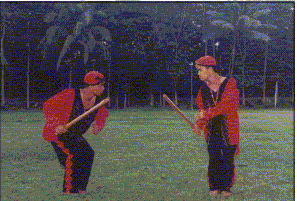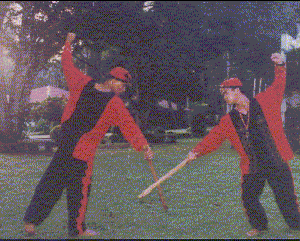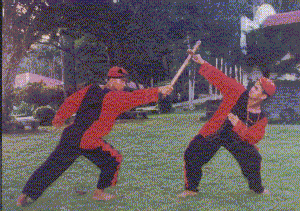|
MINONGGUYANGAN: A MANOBO WAR DANCE
Prof. Ma. Chelou G. Loque
Meaning : War Dance
Place of Origin : Agusan del Sur
Ethno linguistic Group : Manobo
Classification : War Dance/Entertainment
Performers : One to any number of pairs of male dancers
Background/Context:
This dance is usually performed
as an entertainment during the Kahimunan, an
occasion when conflicts between two communities are resolved by the Datus. Serious conflicts between communities are settled
through the Bila, or a peace-pact to put an
end to the cycle of vengeance from which such conflict may generate. The Bila is established with the use of a candle, eggs,
ceramics plates, a piece of rattan and a sacrificial chicken. The animal is sacrificed to the spirit during a ritual accompanying
the proceedings, and then the lighted candle is extinguished, the eggs thrown to the ground, the plate shattered and the rattan
cut to symbolize what would happen to those who violate the pact. These movements may also mark the severing of the cycle
of violence or destruction. This occasion ends up with dancing and merry-making.
Movements Particular to the Dance:
Ikid-ikid – similar to parallel tortillier
Yakang- sibog – step hop r forward, step hop L backward
Yaksu – with close feet, take small jump sideward R and L
Yakang-sibog-patiligut – step hop R and L and two-step hop turn
R
Yakang-yaksu – step L and Leap R forward
Basic Arm Movements:
Liguton – circular wrist motion at waist level
Sagang – alternate up and down motion of forearm in front, palms
in
Palikid-likid - similar to figure of eight moving R and L
Dugsak – R arm thrust forward
Payu – a. strike ulisi with partner forming X downward
b. strike ulisi with partner forming X overhead
Dance Properties
Costume:
Male: Typical Manobo costume using the prescribed color (red ,black,
yellow and white)
designed with Suyam or Manobo
embroidery.
Musical Accompaniment:

Count: 1 & 2 or 1, 2 to every measure
Formation: One to any numbers of pairs of male dancers
Props Used: Ulisi – made
of hard wood at about 2.25 feet long
Instrument Used: a. Agong – a musical instrument made of brass
b. Gimbae – like a drum made of skin of a deer

|
| Figure 1 |
Face Audience
Take four Ikid-ikid steps sidewards
R, R arm execute liguton while free hand on
waist………………………......……..... 4M
Repeat (a) sideward L, same arm movement ……….…….…4M
Repeat (a-b) facing partner………………………….…….….8M

|
| Figure II |
Face Partner
a. Take eight Yakang-sibog R
and L moving clockwise to partners,
arms in Sagang movement………………………….….8M
b. Repeat (a) counterclockwise to partner’s place,
same arm movement………………………………........8M

|
| Figure III |
Boy 1: Face Partner
Repeat figure II (a) in place……………………………….…..8M
Repeat Boy 2 (a-b), same arm movement………….....…….…8M
Boy 2: Face Audience
Execute a Yakang-sibog-patiligut, R
arm in Liguton
movement……………………………………………......4M
Four yaksu steps ( two jumps
sideward R and L in every measure).
Arms in palikid-likid…………………………….…......4M
Figure IV
Face Partner
Execute a yakang-sibog-patiligut, place
ulisi at the back.….4M
Boy 1: four yakang-yaksu forward
with dugsak movement
Boy 2: four yakang-yaksu moving
backward, arms in
palikid-likid ………..…….…………………………...4M
Repeat (a-b). Boy 1 moving backward while Boy 2 moving forward…………………………………......8M
Figure V
Repeat Figure II …………………………………………………….16M
Figure VI
Face Partner
Repeat Fig. IV (a)…………………………………………….4M
Boy 1: four yakang-yaksu forward,
R arm execute the Payu (a) as offense
Boy 2: four yakang-yaksu backward,
r arm execute the
Payu (a) as defense……………………………………...4M
Repeat (b), this time Boy 1 as defense and Boy 2 as offense.
R arm n Payu (b)……………………………………….4M
Two yakang-sibog-patiligut steps
R, Ulisi is placed at the
back……………………………………………………..2M
Jump to stride R foot forward, execute Payu (a) 1M and
Payu (b) 1M…………………………………………….2M
EXIT
Execute a yakang-sibog step arms
in sagang movement…………………………………………..…16M
|

